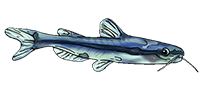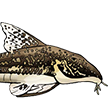With the above in mind, what is your opinion on the photos in cat-e-log as half of them have vermiculated heads?
easy: the catelog is not a by dogma 100% foulproof infostash
I've seen and still see plenty misidentified fish in there
the fact that there are such fish labelled in the catelog is not proof at all!
it should be the reverse....
first a proper determinated fish, then it goes in the catelog
not backwards

maybe Synodontis ornatipinnis does have a vermiculated head when young and does it turn into spots when they mature
it could be the case
we know for example that Synodontis eupterus starts out as vermiculated and turns to spots when it matures
but that also gives me a HUGE warning.......because that very species is the most used species when it comes to fabricating hybrids
plenty other Synodontis with a black, white and grey make up and wich have spotted heads do NOT change from vermiculated when they mature
Synodontis petricola, Synodontis polli, S multipunctatus, S pleurops, S decorus, S brichardi (!!) etc etc.
the case against these is that the closest relatives have spotted heads when young. some retain the spots, others get a darker color.
but -
I'm not 100% sure, but I strongly suspect- I assume that the closest relatives of Synodontis ornatipinnis are Synodontis decorus, Synodontis brichardi, Synodontis pleurops and maybe even Synodontis acanthomias.
none of these have vermiculated heads; ALL start out with a finely spotted head and a spotted or banded body.
in ornatipinnis the body pattern turns from bands in fry to a very contrasted vermiculated pattern but the head stays spotted
in decorus the head is spotted, the body of a baby decorus has a few big dark spots, NOT vermiculated bands and the number of spots increase with age. the fins are bandad horizontally in youngsters and adults both.
in brichardi the bands get bigger and in some cases curl up to something resembling a bit of vermiculate. the spotted head turns darker and the fine grey spots are very hard to see on the grey background color. the fins are banded in both younsters and older fish.
in pleurops the head is spotted, the body vermiculated and old specimen loose the vermiculate body pattern, but retain the very fine brown spots on the head. these are hard to see on darker specimen
another Syno wich to me resembles a "mini pleurops" also has a spotted head: Synodontis contractus.
No I don't think these are genuine.
yes I am a bad tempered paranoid kind of person that doesn't trust others and usually assumes the worst....but that doesn't automatically prove me wrong, does it?














